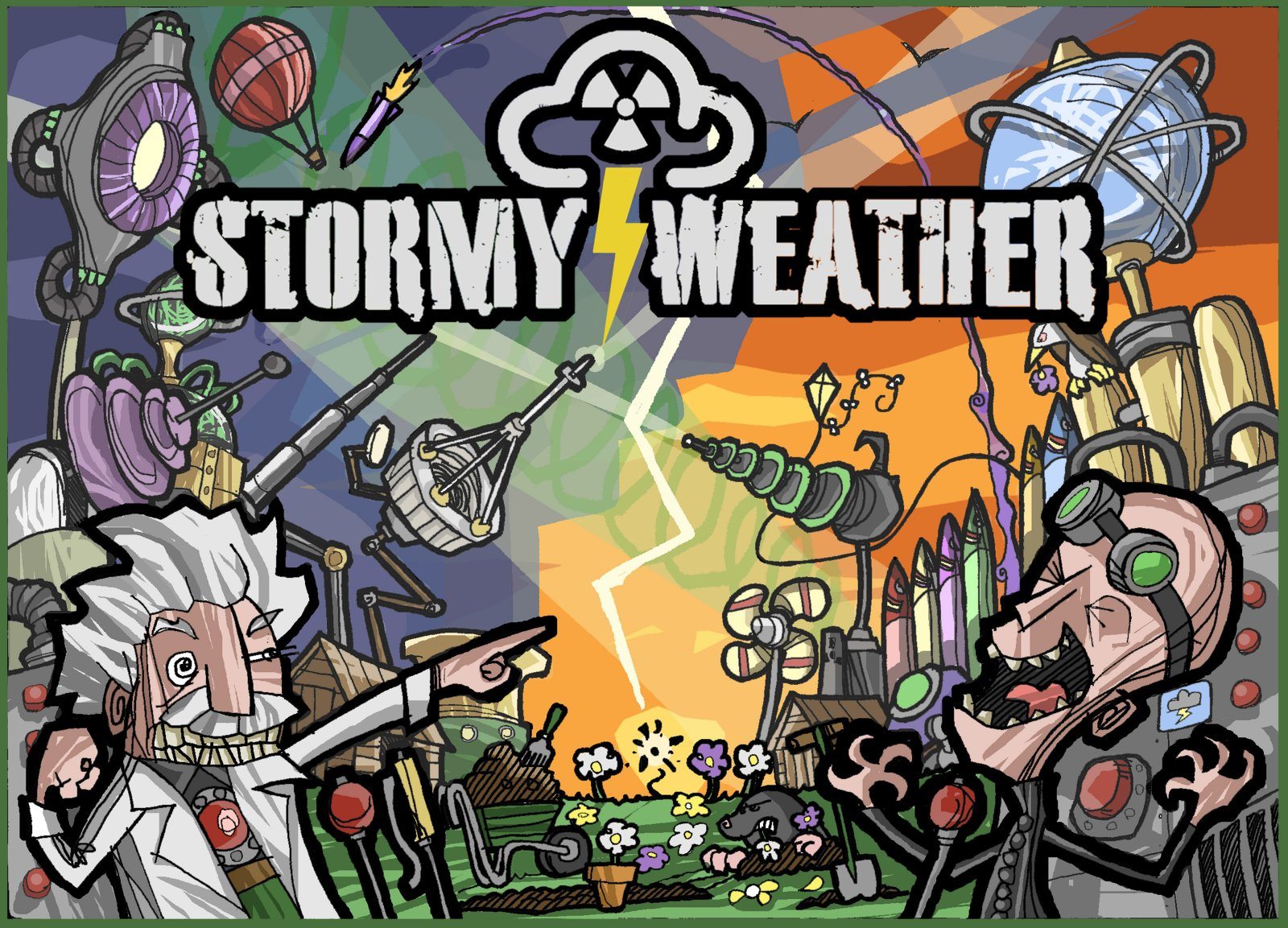Table for Two is a series focusing on two-player board games. Today’s game is Stormy Weather, a game about mad scientists and … gardening.
Being a mad scientist is fun, but you gotta retire eventually. Maybe find a little village, settle down, work on your garden… Blast! Your arch-nemesis is doing the same thing. Well, if you’re going to win that Transylvania in Bloom trophy, maybe it’s time to dust off your mad skills and fire up the weather machines. Expect a bit of Stormy Weather.
At a glance: Stormy Weather is a game for 2 players, ages 12 and up, and takes about 45 minutes to play. It just launched on Kickstarter, and the pledge level for a copy of the game is £25 (roughly $40). I think it’d be fine for kids as young as 8, although the strategy and managing the various weather machines might be tricky for less experienced players. Also, just as a side note, there is one card called “D**n the Overload” in case you avoid swearing around your kids.

Components:
Note that the version I played was a demo prototype, so this list may be subject to change.
- 1 board
- 45 weather tiles (cloud, sun, rain, heatwave, lightning)
- 10 flower tokens
- 20 sun and rain markers
- 20 damage markers
- 40 weather machine cards
- 6 mad scientist cards
- 8 taunt cards
- 1 round marker
The artwork for the machines by Sam Zuppardi is cartoony and really great, as are the names of the machines and their effects. It’s a cute style that’s a better fit than photorealistic illustration, considering the over-the-top theme. I don’t know if the weather icons (clouds, sun, rain, etc.) are final but they’re also bold, easy to identify, and somewhat iconic, reminiscent of a TV weather forecast map. The “taunt” cards in my copy weren’t finished, so I don’t know what they’ll ultimately look like, but they have great titles that reflect classic bad guy lines.
How to Play
For more about the game, you can visit the Stormy Weather website, which includes print and play files so you can try the game yourself, but here’s how it works.
The aim of the game is to grow the most flowers by the end of the game, which lasts over 5 play periods. You’ll use weather machines to bring sunlight and rain to your flowers, and (you hope) lightning and heatwaves to your opponent’s gardens.

To set up, each player takes a pair of weather machines—the A, B, C, D labels will determine which player goes first, but then starting player will alternate in subsequent periods.
The board itself is a 5×3 grid with five flowerbeds on each edge. You place the board between the two players so that the flowerbeds are near the players. The board starts out filled with weather tiles, a mix of sun, rain, and clouds. (If you’re using the Mad Scientist expansion, each player also draws a scientist at random from the deck before picking machines. The scientist cards give specific abilities that can be used throughout the game.)
The whole game is five play periods (think of them as weeks, perhaps), and each play period has these four phases:
- Manipulate Weather
- Gardens Grow
- Recharge Weather Machines
- Select New Weather Machines
During the last period, you’ll also have an additional step 1.5 between manipulating weather and growing the gardens: Play Taunts.

Phase 1: Players alternate using their machines to alter the weather. Once you’ve used a machine, you flip it face down (showing the “recharging” side). This phase lasts for five rounds, which are tracked with the Round marker token on the board. If at any point all of your machines are recharging or none of your charged machines can be used (or have any effect), then you may automatically recharge all of them.
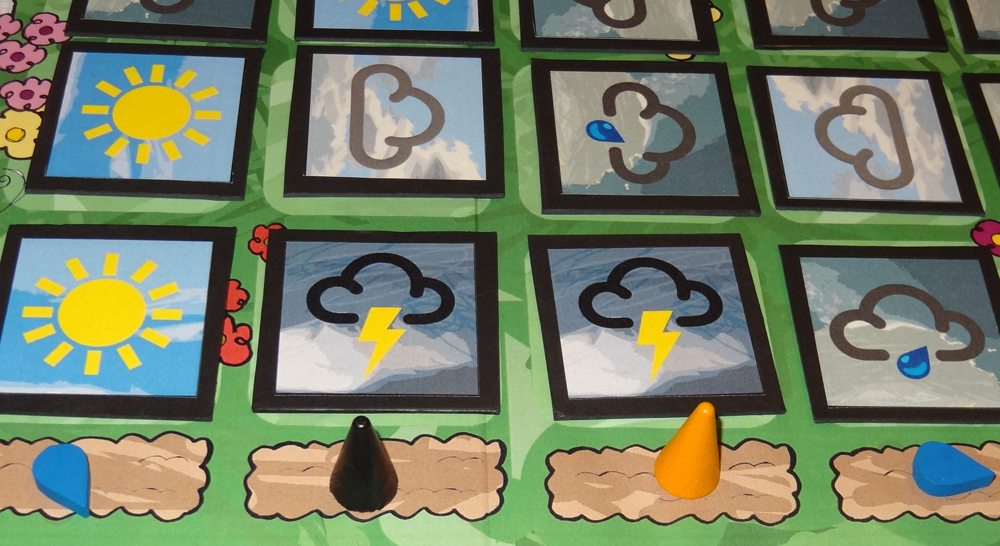
Phase 2: To grow your gardens, you look at the weather in the five spaces directly adjacent to your flowerbeds. You add either a sun or rain token to the flowerbed if there’s sun or rain next to it. To grow a flower, you need a rain token and a sun token (which takes more than one period to achieve). Clouds don’t do anything. Lightning and heatwaves will damage flowerbeds: lightning removes sun tokens and heatwaves remove rain. If there are flowers already present, the extreme weather makes them wilt. After resolving effects and growing new flowers, excess tokens are removed (you can only have either sun, rain, or a flower in each flowerbed).
Phase 3: You recharge any of your weather machines that are still recharging.
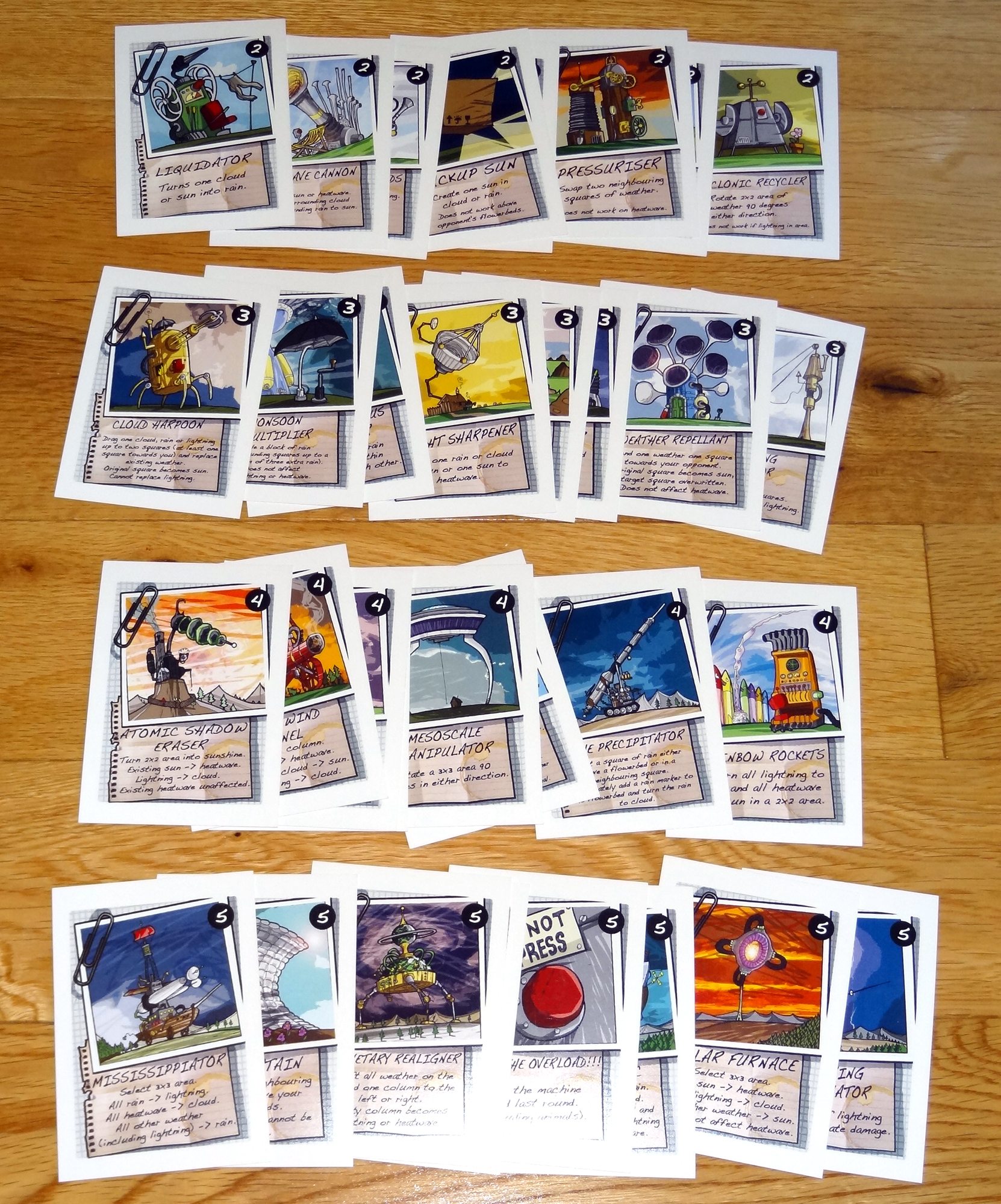
Phase 4: You get to pick new weather machines! The machines are arranged in decks corresponding to the play periods, and as the game progresses the machines get more and more powerful. First, you shuffle the machines and remove two at random. Each player will get to pick two machines and add them to their arsenal—er, horticultural toolshed.
Then the next play period begins, with the other player acting as starting player.
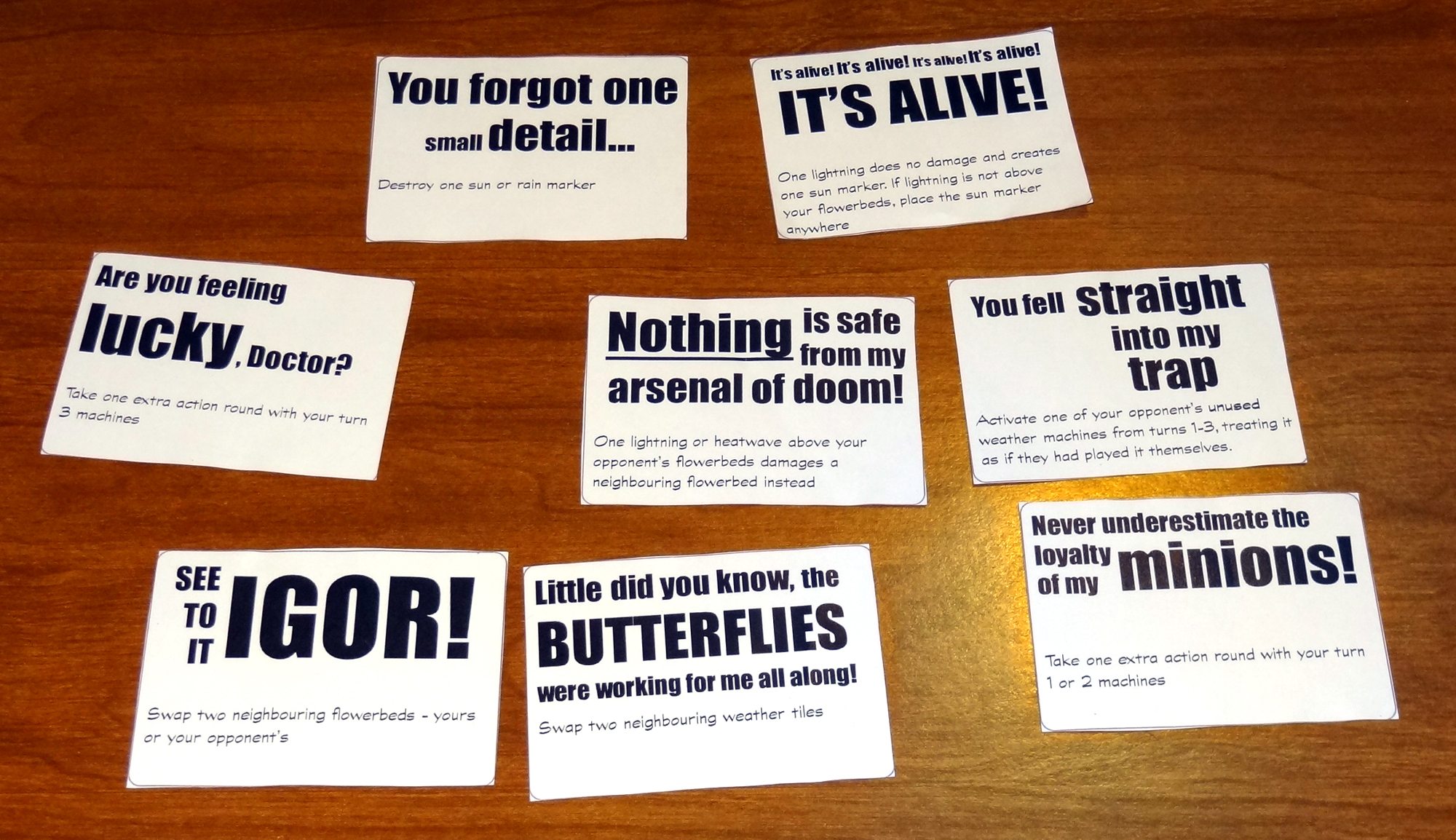
During the last period, you throw in the taunts before the gardens grow. These will let you take one last potentially game-changing action.
Once the fifth period is over, the player with the most unwilted flowers wins. In case of a tie, compare wilted flowers, then remaining sun and rain tokens. If there’s still a tie, or nobody was able to grow any flowers, then “angry villagers storm the homes of both players and trample all over their begonias.” Time to take up a different hobby, I suppose.
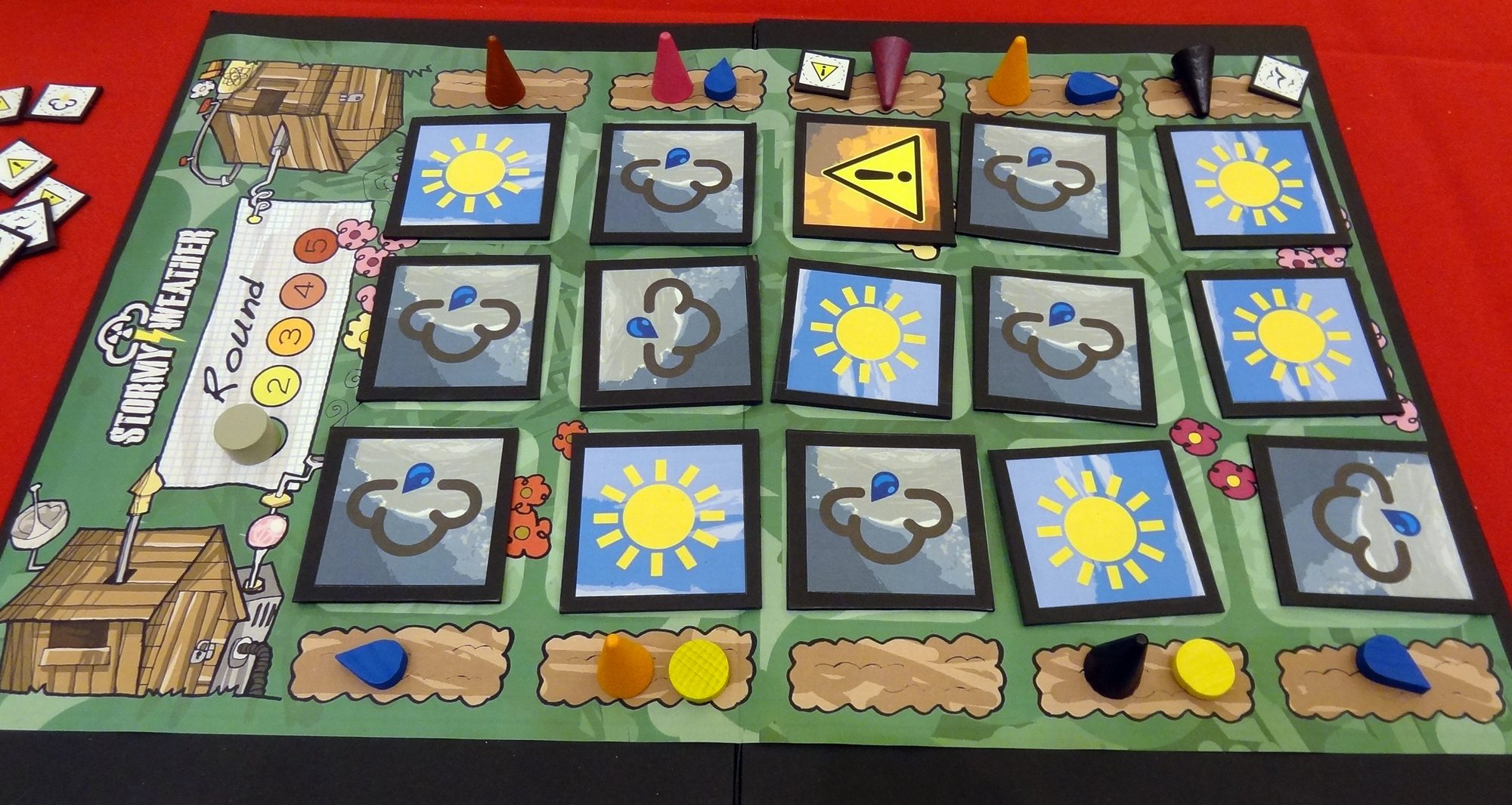
The Verdict
I love evil geniuses—particularly those that conform to all the stereotypes, with their ranting monologues and cliched comebacks and complicated plans to take over the world. It’s why one of my favorite novels is Soon I Will Be Invincible, because half of the book is told from the point of view of a nefarious supervillain. It’s the same reason I enjoy movies like Megamind and Despicable Me and Dr. Horrible, because don’t we all feel like vaporizing our enemies every so often?
However, I’ve been generally disappointed in the lack of evil genius board games. Years ago I picked up a copy of Mwahahaha!, excited by the chance to play an evil scientist building a doomsday device. The artwork was fantastic and the humor was spot-on, but the gameplay just didn’t quite hold up to the promise.
So I was a little skeptical at first when designer Michael Dnes asked me to take a look at Stormy Weather. Mad scientists using weather machines to grow flowers? It sounded like a perfect zany blend, but I’ve been burned before.
Well, I’m delighted to report that Stormy Weather is all sunshine and flowers. Er, and evil worms and lightning and planetary realigners. That is to say, it’s great fun. First off, the theme is a lot of fun. Growing pretty flowers by pulling rain clouds toward you and sending heatwaves at your opponent is pretty awesome, particularly when you get to laugh maniacally while you’re doing it.
The gameplay is simple enough to learn—in fact, the hardest part is remembering to move the round marker while you’re using your weather machines, because who has time to keep track of something trivial like rounds when you’re manipulating the clouds themselves? Sorry. The one confusing bit was the way the terms “rounds” and “turns” were used in the rulebook, but I’ve mentioned this to Dnes and hopefully it’ll get sorted out. The machines themselves tend to be pretty self-explanatory.
I’ve already mentioned that I like the artwork a lot—it’s a good match for the game, and I love all the illustrations of the crazy weather machines. I’m actually tempted by the £150 reward level to get myself drawn into the game as one of the evil scientists, but we’ll see. That’s a lot of Kickstarter projects I could back…

I also like the escalating machines. In the first period, you just have machines that let you mess with the rain, sun, and clouds. While you can sometimes pull good weather away from your opponent and leave them with just a cloud (that does nothing), you can’t really damage them. However, as the game progresses you’ll have access to more and more powerful machines—you’ll start to add lightning and heatwaves to the board. By the end of the game you may be using the Noah-matic to turn an entire 3×3 area into rain and spreading lightning around.
The end-game taunts are a nice touch. In my experience, they didn’t always pan out, but it’s fun to get one last jab in there before the game ends, and I like the names of the taunts. Creative Room Games is also going to be running a contest on their website to submit taunts that may be included in the final game.
The game has a lot of replay value, because it changes based on the types of machines you and your opponent pick. In one game, you may find that you have a lot of rain early on because nobody picked sunny machines. But in the next if you overcompensate you’ll find yourself with a lot of heatwaves on the board.
There’s not a lot of luck involved—basically just in the taunts you receive, the mad scientists (if you use that expansion), and the two machines that get discarded each period. Otherwise, everything depends on the choices you and your opponent make, and since all the machines are out there in the open, you can see exactly what your opponent’s options are as you play. While this can lead to a little bit of analysis paralysis in those prone to it, I think overall it makes for great gameplay. It’s a battle of wits; evil geniuses don’t rely on something as capricious as chance.
As I mentioned above, the game is mostly kid-friendly—you can decide if the one appearance of “d**n” bothers you, although you could just pull that card out if you had to. Dnes explained that for the Brits, it’s considered pretty mild, but he might try to put in a kid-friendly extra replacement if things work out.
Price-wise, $40 may be a little higher than what I’m used to paying for a two-player game, but part of that is that I don’t play as many two-player-only games. Still, with the amount of replayability and the sheer fun factor, Stormy Weather could be worth it. Remember, you can always try out the demo print-and-play version to see what you think before backing.
Overall, I was pleasantly surprised by Stormy Weather and I’m eager for it to get funded. Take a look at the Kickstarter page for more!
Disclosure: GeekDad received a demo prototype of this game for review.

